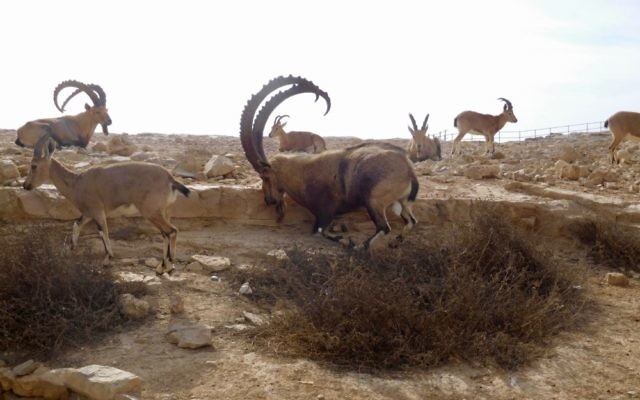Day 4 Israel Ride 2016: Mitzpe Ramon to Kibbutz Ketura
Throughout the 2016 Israel Ride Nov. 8-14, Morris Maslia will be providing posts of insights and photos of the exciting and transformative event.
Cyclists spent an awe inspiring Shabbat (the Jewish sabbath) in the breathtakingly beautiful Mitzpe Ramon that sits atop the Makhtesh Ramon at 2,800 ft above sea level. Cyclists and guests could attend services, exercise, swim, walk, partake in a yoga class, or simply relax, while enjoying the magnificent views form Makhtesh Ramon with the desert Ibex that inhabit the steep mountain cliffs. Shabbat was concluded with a spiritually meaningful Havdalah service at the edge of the Makhtesh.
On Sunday morning, which is Day 4 of cycling, all riders gathered at the top of Makhtesh Ramon to take the 2016 Israel Ride group photo before starting the first of three very big descents for the day. With the morning sun just rising above the horizon, the group photo was completed. The JNF-Atlanta team posed for a group photo with the top of the Makhtesh and a couple of desert Ibex in the background.
The first BIG DESCENT of the day began with cyclists leaving the high top of the Makhtesh one at a time (for safety) and descending from about 2,800 feet down to about 1,000 ft over the switch-back two-lane road covering a distance of about 2 miles. This rider hit speeds exceeding 35 miles per hour (on two very thin 25 millimeter thick road bike tires), although some riders exceeded speeds of 45 miles per hour. What a thrill it was descending into the cool morning air of Makhtesh Ramon. The rest of the morning was spent cycling along Israel Highway 40 that traverses the bottom of the Makhtesh and through areas such as Wadi Paran.
To complete Sunday morning’s cycling before taking a lunch break, we next had to climb out of the steep hills of Wadi Faran that is characterized by a two-lane, switchback road with no shoulders and jutting rock hill faces. Cars, motorcycles and buses, pass cyclists going up hill and sometimes leaving less that 6-inches of space between the cyclist, the vehicle, and the sharp rock faces. Staff and crew sit high above Wadi Faran on a hill top cheering cyclists on as they reach the climax of the road and the last major climb of the day.
We lunched at Kibbutz Shitim. Shitim is the Hebrew word for Acacia Trees that dot the desert landscape and are always a sign of the availability of some water source as well as providing a much needed bit of shade after cycling in the blistering Negev sun. Kibbutz Shitim is located near the Plains of Moab, where biblically, the Israelite men had their way with the Moabite women. Cyclists have requested a visit from some Moabite Women from ride organizers for the 2017 Israel Ride lunch stop at Shitim!
After the lunch break, cyclists biked about 14 miles until a safety check stop at Har Ayit. This is the point whee the last steep descent of the day of about 1,000 feet takes place as cyclists reach the Day 4 stoping end point of Kibbutz Ketura. The steep 3-mile descent is another exhilarating downhill ride through the Eilat Mountains. Kibbtuz Ketura is the home of the Arava Institute for Environmental Studies , where environmental study is used as a framework to discuss and learn about local and regional issues of concern among Israeli (Jews and Arabs), Palestinian, and Jordanian students. These students will be future environmental leaders of the region.
After completing the steep 3-mile descent and arriving at Kibbutz Ketura, cyclists celebrate the day’s cycling efforts and downhill achievements by relaxing at the cafe and store. Later, they partake in a number of educational meetings about the Arava Institute and activities on Kibbutz Ketura and hold discussion with current students. More about these activities in a subsequent blog.




comments